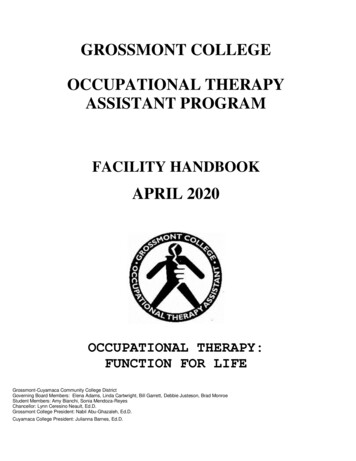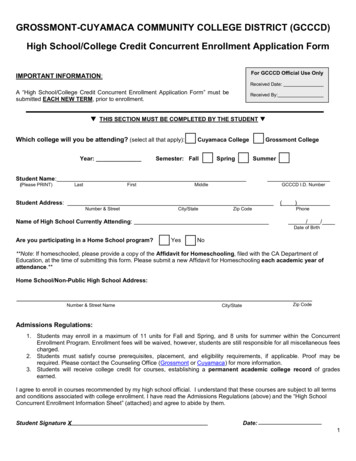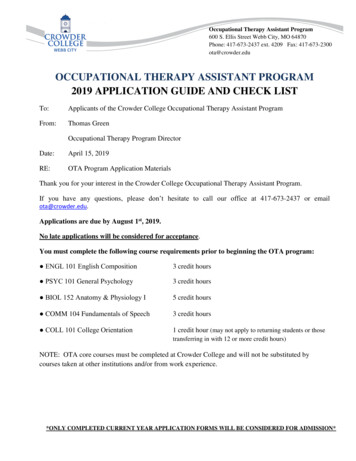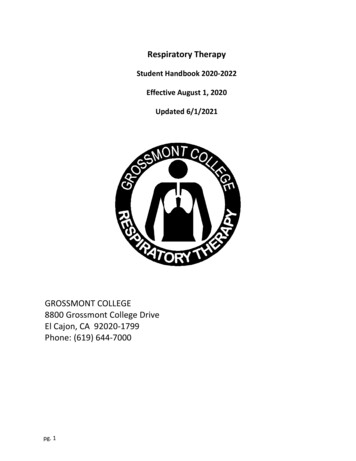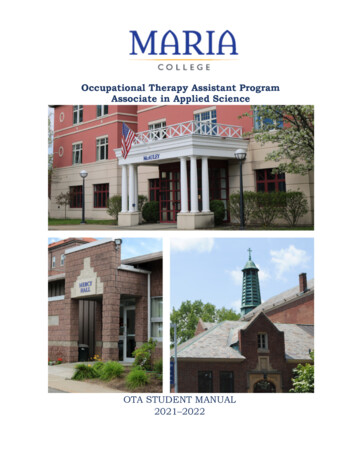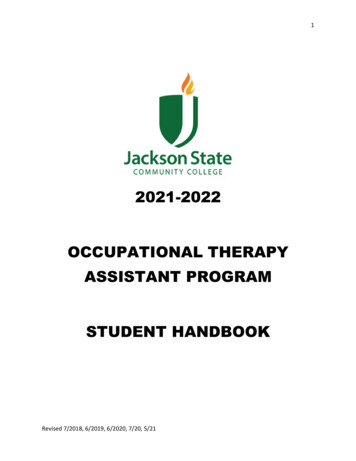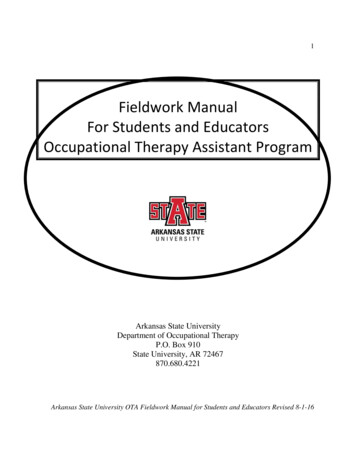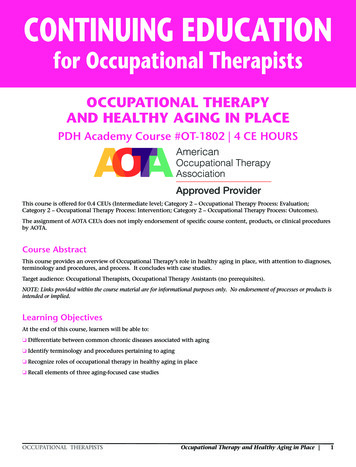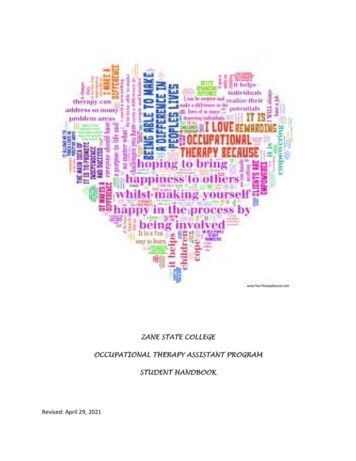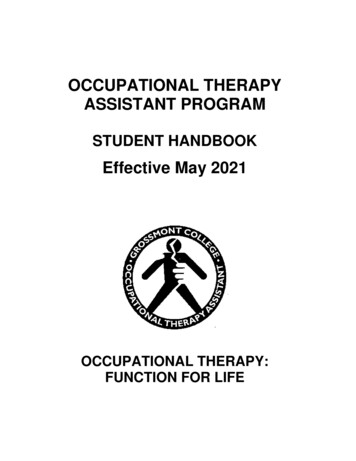
Transcription
OCCUPATIONAL THERAPYASSISTANT PROGRAMSTUDENT HANDBOOKEffective May 2021OCCUPATIONAL THERAPY:FUNCTION FOR LIFE
2
DEPARTMENT CONTACTS: OTA Program Director OTA Fieldwork Coordinator OTA Health SpecialistChristi VicinoJoyce Fries OTA E-mail du Website(619) 644-7304(619) 644-7307(619) /OTA Grossmont College8800 Grossmont College DriveEl Cajon, CA 92020-1799(619) 644-70003
OCCUPATIONAL THERAPY ASSISTANTTABLE OF CONTENTSSIGNATURE PAGEGrossmont College OTA Program Student Handbook Signature Page .7SECTION I – OTA PROGRAM OVERVIEWEducational Philosophy .Mission Statements.Definition of the Profession of Occupational Therapy.Occupational Therapy Assistant Program Philosophy .Approach to Learning/Instruction .Program Objectives.Program Outcomes/Competencies . .Curriculum Design.Associate Degree Major Requirements.OTA Associate Degree Program Content and Sequence .Prerequisites.Core Courses.General Education Courses .Recommended Sequence .Description of OTA Core Courses .101010111112121315161616161719SECTION II - OTA PROGRAM PROFESSIONAL BEHAVIOROccupational Therapy Code of Ethics (2015) .Student Code of Conduct.Professional Behavior Evaluation Guidelines .Professional Behavior Evaluation Guide .22293031SECTION III – OTA PROGRAM PAPERWORK REQUIREMENTSStudent Checklist.Background Check/Drug Screen .Malpractice Insurance .CPR Card.TB Clearance.Physical/Medical Examination .Consent Form for Medical Records .Flu Shot.Proof of Health Insurance .Essential Functions of OTA Student .Accessibility Resource Center .3539414142434343434447SECTION IV – ACADEMIC POLICIES OF GROSSMONT COLLEGE OTA PROGRAMAcademic Integrity.Technology – Social Networking Sites/E-mail/Texting, Computers, Cell Phones, Recorders .Standards for Written Work .OTA Attendance Policy .Fieldwork Attendance Policy .OTA Grades and Dismissal .Safety, Professional, Legal and Ethical Infractions .OTA Skills Checkoff . .OTA Lab Requirements When A Student Accepts But Does Not Attend .Illness/Extended Illness/Post Surgery/Pregnancy .Medical Clearance Form .4505254565758616262626265
Textbooks and Supplies .OTA Dress Code Emergency Contacts/Personal Information Confidentiality – FERPA – Grade Access-Records .Standard Precautions and HIPAA Requirements Counseling and Modification of Major Clinical Facilities/Affiliations .Transportation Student Health Insurance .Personal Hygiene .Child Care Graduation .Gift Policy .Non-Discrimination Policy OTA Office .676970707171717272727273737373SECTION V – FIELDWORK – CLINICAL – EXPERIENTIAL INFORMATIONFieldwork Level I and II Descriptions .Level I Fieldwork Objectives .Level II Fieldwork Objectives .Developing Professional Behaviors through Fieldwork .Fieldwork – Suggestions for Students .Student and Faculty Advisement .Fieldwork Student Counseling Agreement .Student Counseling Agreement .Behavioral Contract 767778798385868788SECTION VI – GROSSMONT COLLEGE RESOURCESRemediation Policy.Scholarship.Student Services.Learning Resource Center .Tutoring Center.Counseling Center.Career Center t.Job Placement Center .English Writing Center .Adult Re-Entry.Financial Aid.Student Health Services .Student Affairs.Associated Students of Grossmont College (ASGC) .Veterans Affairs Office .Extended Opportunity Programs and Services (EOPS) . .Cooperative Agencies Resources for Education (CARE) .9292929292939393939393939394949494SECTION VII – PROFESSIONAL ial of Licensure.NBCOT.Board of Occupational Therapy .Accreditation.9696969696969696SECTION VIII – WORKERS COMPENSATION/EXIT/RE-ENTRY/APPEALS FORMS5
Reporting on Campus OR Clinical Site Injury/Illness/Accident .On Campus Injury/Illness/Accident Form .Program Exit Form.OTA Exit Interview Policy .Re-Entry Policy.Re-Entry Application.Grossmont College OTA Program Problem Solving Process .OTA Program Appeals Process Form .98101103104105106107111Section IX – UPWARD EDUCATION MOBILITYOT Schools in California .6113
Grossmont College Occupational Therapy Assistant ProgramSTATEMENT OF UNDERSTANDINGI,, have read and agree to adhereto the policies and procedures set forth in the Effective May 2021 OTA Student Handbook. The OTA Student Handbook is adynamic document and is subject to change as polices evolve. Students are responsible for knowing the content of thecurrent OTA Student Handbook and adhering to its policies. If an addendum is necessary, students are responsible for anyadditional policy changes.In addition: For learning purposes and marketing, students may be digitally recorded, video-taped when participating insimulation, skills practice and skills testing, including testing done with remediation during the semester, and testingdone for program re-entry, or OTA activities on site and off site. Images, audio, and videotape taken while in theOTA Program are the property of GCCCD and may be viewed by community partners for marketing or educationalpurposes. My signature indicates that I have read the handbook and I agree to be recorded. In exchange for the educational opportunities provided to me by the clinical site, I agree to comply with all state,local, and federal requirements governing the privacy of medical information. Those privacy requirements havebeen explained to me and I have had training in complying with these requirements. I agree to uphold all HIPAAand other privacy requirements during my clinical rotations. I understand that HIPAA violations may result indismissal from the OTA Program. I understand that I am bound to comply with all privacy requirements when I am not in a clinical rotation, including inmy conversations with family, friends, and peers. I will not utilize my cellphone or recording device in clinical siteareas where clients are or could be present even if site allows photographs or video. I will be held accountable formaintaining the privacy of any information I obtain, see or am given during my clinical rotations. To uphold theprivacy of such information, I agree not to post or discuss any clinical experience or information regarding myexperience with the clinical agency, its staff, or its clients/patients on any internet social media (Facebook, Twitter,E-mails, Instagram and any others not mentioned). I agree to uphold the “zero tolerance” policy for pictures, video,or audio taken on any clinical site while in my role as an OTA student. I understand that administration periodicallysearches the internet for breaches in its privacy policies. Failure to follow these policies will result in removal fromyour clinical site and exit from the OTA Program according to the exit policy. California is a two party consent law state with regards to wiretapping laws. California makes it a crime to record oreavesdrop on any confidential communication, including a private conversation or telephone call, without theconsent for all parties to the conversation. Cal Penal Code 632. Student must have completed current immunizations, TB, CPR, malpractice, background check, drug screen,HIPAA and standard precautions paperwork AND be officially registered prior to the start of the first class for allrequired OTA courses in order to attend and are not permitted in class, labs, or any clinical area on campus or offcampus clinical sites.My signature indicates that I have read and understand the program expectations and agree to abide by the OTA StudentHandbook policies and procedures.*If you have any questions regarding the policies in the handbook before signing this form, please make an appointment withthe OTA Program Director prior to signing this statement of understanding.Student SignatureDatePrint Name7
8
SECTION I: OTA PROGRAM OVERVIEW9
EDUCATIONAL PHILOSOPHYGROSSMONT-CUYAMACA COMMUNITY COLLEGE DISTRICTThe Grossmont-Cuyamaca Community College District Governing Board believes that a community college should provideexperiences that will greatly broaden students’ educational opportunities and strengthen society’s democratic institutions.Grossmont and Cuyamaca Colleges are committed to provide an education through which students may create rewardinglives, productive for themselves and for society, based on an understanding of the relationship between the past, and thechallenges of the present and the future.The Grossmont Cuyamaca Community College District Governing Board accepts and is committed to the following premises: The democratic way of life allows each individual the personal freedom and initiative consistent with his/herresponsibilities to other persons.Grossmont and Cuyamaca Colleges recognize the value of our diverse and individual needs, interests, andexperiences, vary greatly.The maximum development of the personal, social, and intellectual qualities of each individual must be encouraged.The development and fulfillment of the individual and the development of the community are increasinglyinterdependent.An educational environment dedicated to these philosophic premises will produce individuals prepared for life and citizenshipin a complex, diverse society and global economy.MISSION STATEMENTSGrossmont College:Grossmont College provides an exemplary higher education learning environment through comprehensive and innovativeinstructional programs and student support services.By advancing equity and inclusion, we prepare our diverse student population to lead and engage with local and globalcommunities.We fulfill our mission by providing the people of East San Diego County with: Associate/transfer degrees and certificate programs Career education and workforce development Preparation for collegiate success Exploration of academic and career options Lifelong learning opportunitiesOTA PROGRAMTo provide a quality educational program that values the uniqueness of all human beings and produces competent andprofessional entry level occupational therapy assistants that will serve diverse populations and settings in San Diego, the stateand the nation. It is also the mission of the OTA Program to encourage students to be life-long learners, provide communityservice and forge into uncharted areas of practice in response to the needs of an ever-changing society.DEFINITION OF THE PROFESSION OF OCCUPATIONAL THERAPYOccupational therapy is the art and science of directing an individuals’ participation in selected tasks to restore, reinforce, andenhance performance; facilitate learning of those skills and functions essential for adaptation and productivity; diminish orcorrect pathology; and promote and maintain health. The central agent in OT is the occupation. Occupations are the ordinaryand familiar things people do each day. Its fundamental concern is the development and maintenance of the capacitythroughout the life span to perform with satisfaction to self and others those tasks and roles essential to productive living.Occupational therapy provides service to those individuals whose abilities to cope with tasks of living are threatened orimpaired by developmental deficits, the aging process, physical injury or illness, or psychological and social disability.Occupational therapy serves a diverse population in a variety of settings such as hospitals and clinics, rehabilitation facilities,long-term care facilities, extended care facilities, sheltered workshops, schools and camps, private homes, and communityagencies.10
OCCUPATIONAL THERAPY ASSISTANT PROGRAM PHILOSOPHYThe Occupational Therapy Assistant Program at Grossmont College prepares the student for an Associate in Science Degree.In addition to the core curriculum, the major requires selected general education courses from the biological, social andbehavioral sciences.The scope and content of the Occupational Therapy Assistant Program at Grossmont College reflect the program’s view ofhumanity and the teaching/learning process, based on concepts defined by Keilhofner (Conceptual Foundations ofOccupational Therapy, 1992) and Reilly (Play as Exploratory Learning, 1976): Human beings, as complex systems, function on many different levels and experience and change when growthoccurs. Human beings are intrinsically motivated to interact with their environments through purposeful activity to positivelyaffect their health. Human/environmental interaction is a continuous process of adaptation that promotes not only survival but alsocuriosity through exploration, competence and achievement. Human beings, as open systems in a dynamic evolving interaction with the environment, process informationthrough: input, throughput, output, and feedback. Human beings have an occupational nature, experience occupational dysfunction and use occupation as atherapeutic agent. Occupational behaviors include purposeful activities that occur on a developmental continuum in the context ofplay behaviors as a child and leisure/work behaviors as an adult.APPROACH TO LEARNING/INSTRUCTIONThe primary goal of the occupational therapy assistant educational process is to produce competent practitioners.Competency is acquired through active exploration of the environment as behaviors are practiced to form skills. Learning isan active, interactive and cooperative process as the individual builds skills related to objects, people and environment.Cooperative learning provides a method to structure the educational environment and facilitate interaction with others for skilldevelopment.Diversity is critical for the occupational therapy assistant practicing in today’s global environment. Diversity is a source ofopportunity and knowledge. The appreciation for differences in potential, unique practice areas and in human beings willenrich the profession of occupational therapy and develop diverse and culturally competent graduates. Through cooperativelearning, culturally diverse students and faculty help to create an environment where strategies can be learned throughteaching others and collaborating with others to achieve mutual goals, thereby facilitating attainment of cultural competenceand diversity. Appreciation of the rich mosaic of differences within the community will fuel growth in the profession.Experiencing volunteer community service through the Occupational Therapy Assistant Program is a life changing event. Theopportunity to explore feelings and emotions that are inherent in the practice of occupational therapy is experienced. Thesense of giving through your own hands without expecting anything in return is integrated into the curriculum.A multimedia approach to education is utilized when possible in order to accommodate variations in learning styles, and toprovide an environment, which stimulates, supports, and challenges the student. Emphasis is placed on self-assessment,evaluation, and motivation throughout the student's progress through the program. It is expected that students assumeresponsibility for their learning and contact the appropriate faculty to access the academic resources designed to promotestudent success.11
OCCUPATIONAL THERAPY ASSISTANTPROGRAM OBJECTIVES1. Be eligible to sit for the NBCOT examination2. Value the uniqueness, dignity and rights of the individual3. Exhibit cultural sensitivity during treatment interactions4. Demonstrate ability to utilize purposeful activity to facilitate adaptation and mediate dysfunction for all age groups,disabilities and occupational roles5. Demonstrate ability to provide quality services in a wide variety of practice environments including uncharted areasof practice6. Demonstrate the necessary occupational therapy skills to meet the practice needs of the occupational therapycommunity7. Exhibit ability to communicate clearly through various means to patients/clients, family members, peers,administrators and community members to convey education and treatment as indicated8. Exhibit behaviors consistent with the Occupational Therapy Codes of Ethics and professionalism whilerepresenting the profession.9. Value continuing education, technical advancement, leadership opportunities, career advancement and communityservice in occupational therapy10. Advocate and promote the field of occupational therapyOCCUPATIONAL THERAPY ASSISTANT PROGRAM OUTCOMES/COMPETENCIESUpon completion of the program, the Grossmont College Associate Degree Occupational Therapy Assistantgraduate will: Pass the NBCOT examinationValue the uniqueness, dignity and rights of the individualExhibit cultural sensitivity during treatment interactionsDemonstrate ability to utilize purposeful activity to facilitate adaptation and mediate dysfunction for all agegroups, disabilities and occupational rolesDemonstrate ability to provide quality services in a wide variety of practice environments includinguncharted areas of practiceDemonstrate the necessary occupational therapy skills to meet the practice needs of the occupationaltherapy communityExhibit behaviors consistent with the Occupational Therapy Codes of Ethics and professionalism whilerepresenting the profession.Value continuing education, technical advancement. leadership opportunities, career advancement andcommunity service in occupational therapyAdvocate and promote the field of occupational therapy12
CURRICULUM DESIGNThe Occupational Therapy Assistant Program curriculum design incorporates five themes woven into the curriculum and three levels oflearning. The design reflects the college mission statement, OTA mission statement and the OTA philosophy. The curriculum design guidesthe placement of course content, sequence and the depth covered at each level. The location of the content within the curiosity levels oflearning and adaptation creates the reinforcement of content that builds upon itself. This gradual stacking of concepts from exploration tocompetency and ending with achievement promotes graduation of professional, competent, diverse and service oriented lifelong learners.OTA 141OTA 121OTA 111ThreadProfessionalismCoursesOTA mpetenceCommunity ServiceOTA 100,110,140,200,220OTA 101,111,130,140,141,200,210,220,221,230OTA 100,101,110,220,230Lifelong LearningOTA 100,140,200,220,230A tree was chosen as the symbol of the open system of our curriculum. It is strong, growing and long lasting. It can reach great heights ifit is taken care of during its early stages of growth. Input of knowledge through the roots provides the nutrients for the student to anchor tothe ground and begin the journey upward during the early stages of exploration. The trunk of the tree is made up layers of exploratorylearning that supports the branches and begins shaping the crown. The curriculum content increases in depth requiring increased criticalthinking and practice of skills creating the competency level. The branches reach out of the trunk and intertwine high up into the crown ofthe tree where achievement begins to take place. The application of the OTA curriculum content during the Level II Fieldwork experiencegives the final shape to the crown and preparation for the OTA graduate to enter the profession at entry level competence.The layers of the trunk run from the roots to the leaves carrying nutrients throughout the tree. The threads of our program run from the rootsto the leaves giving the students nutrients throughout the program and reinforcing our mission.The leaves give the tree color as the new students give the profession color releasing fresh oxygen into the world of occupational therapy.The program offers continuing education to assist with keeping the community renewed.13
EXPLORATIONExploration requires a safe environment for learning. It is stimulated when something is new or different and behavior is engaged in for itsown sake to support the capacity for object interest. A highly pressured or anxiety provoking environment is an enemy to the process.Exploration reflects an autonomous capacity to be interested in the environment. Hope and trust are fostered as the imagination searchesfor rules of how people, objects and environments operate. The foundations of learning occur at this level. The first sequence of coursesis designed to facilitate exploration in learning the basic rules around principles, activities, communication, documentation and movement inthe delivery of occupational therapy services.OTA 100 - Fundamentals of Occupational TherapyOTA 101 - Fundamentals of Activity/Therapeutic MediaOTA 102 – Rehab Terminology, Diseases and DiagnosesOTA 110 – Occupational Skills - PsychosocialOTA 111 – Experiential/Simulation IOTA 120 - Documentation in Occupational TherapyOTA 130 - Dynamics of Human MovementCOMPETENCYCompetency emerges from intrinsic motivation to deal with the environment, influence it actively and be influenced by it through feedback.To become competent one needs to practice, repeat, and learn behaviors to the point of the establishment of habits. Through practice,competence is accomplished. Fragmentation is a natural part of this process that occurs when sequences of tasks are broken down andreordered during learning. Hope and trust are transformed to self-confidence and self-reliance at this level. The second sequence ofcourses provides an opportunity to practice, reorder, and apply previous knowledge to a wide range of ages, disabilities, and contexts.OTA 140 - Occupational Skills Development in Pediatric RolesOTA 141 – Experiential/Simulation IIOTA 200 – Introduction to Occupational Skills in Physical RehabOTA 210 - Assistive Technology in Occupational TherapyOTA 220 – Advanced Occupational Therapy Skills for Physical DysfunctionOTA 221 – Experiential/Simulation IIIOTA 230 - Occupational Therapy ManagementACHIEVEMENTAchievement builds on the previous two levels. Competition with self or others occurs focusing on a standard of excellence. There is anelement of danger and risk taking involved at this level as the mind employs strategies to strive for success. The student applies andintegrates previously learned knowledge through clin
The scope and content of the Occupational Therapy Assistant Program at Grossmont College reflect the program's view of humanity and the teaching/learning process, based on concepts defined by Keilhofner (Conceptual Foundations of Occupational Therapy, 1992) and Reilly (Play as Exploratory Learning, 1976):
